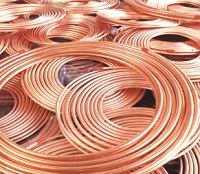Copper Sees Three Consecutive Days of Losses, What’s Going On?
 Although precious metals are thus far enjoying a hallmark year, the market for industrial metals is something else entirely. Not only will regular readers of this space recognize that, but anyone watching the commodities news this week will have seen it. Copper for July delivery is recently down to $2.2245 per pound on COMEX, with some investors saying that copper is finally consolidating its position.
Although precious metals are thus far enjoying a hallmark year, the market for industrial metals is something else entirely. Not only will regular readers of this space recognize that, but anyone watching the commodities news this week will have seen it. Copper for July delivery is recently down to $2.2245 per pound on COMEX, with some investors saying that copper is finally consolidating its position.
But whenever prices go down for a consecutive period, it’s worth zooming out and finding the root causes. That way, in the future, we’ll all be better investors by understanding what really pulls the strings in industrial metal markets.
The First Place To Look: Supply And Demand
Frequent readers here will know that when it comes to copper, as it does just about any commodity out there, the first place to look for answers is in good, old-fashioned supply and demand.
According to the Wall Street Journal, “[Copper] has gotten a boost in recent weeks from improving economic data out of China, the world’s largest copper consumer. However, some analysts doubt the sustainability of copper’s gains, pointing to signs that the Chinese economy is still suffering from weaker growth.”
China has been one of the most important players in copper for a while now, which is why Chinese demand for the industrial metal has such a major impact on the market. The Daily Mail reports that “Three-month copper on the London Metal Exchange was down 0.1 percent at $4,897.50 tonne by 0750 GMT. The metals slipped to $4,873 in the previous session, the weakest since April 19.”
The Other Factors In The Price Of Copper
What affects the supply and demand of copper? There are a number of variables, but given the recent performance of the industrial metal, it’s apparent that 2016 will see some important factors in particular:
-
Manufacturing. Manufacturing in China in particular has a major impact on demand for copper. The same is true for other high-manufacturing countries.
-
The housing industry. Copper was hit particularly hard by the ’08 real estate and economic crisis, as new home building tends to float the demand of copper.
-
Other metals including aluminum, iron, nickel, and lead, the other base metals, also help create the price environment for copper. Knowing how these copper alternatives perform isn’t a great predictor of copper’s success, and reading the base metal news can sometimes make your head spin, but it’s always worth paying attention to.
-
Speculation and short-term investments. Hedge funds sometimes trade in copper to the point that prices may be affected.
A three-day slide may not seem like much, but investors who want to find trends in base metals will want to identify weeks like this in order to see where the arrow may be pointing in the future. With potential for a weak world economy in 2016, which leads to weak manufacturing, this may warrant a cautious approach to copper for the time being. Be sure to watch all of the factors in the price of copper in order to stay on top of the base metal news.

















